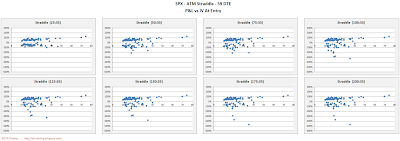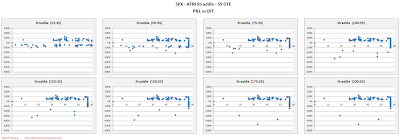For background on the setup for the backtests, as well as the nomenclature used in the charts and tables below, please see the introductory article for this series: Option Straddle Series - P&L Exits.
No IV Rank Filter
In this section we will look at the results of entering one trade for every monthly expiration regardless of the implied volatility rank (IVR) of the SPX on the date of entry. Entering these trades at 59 DTE and utilizing our loss exits and 35% credit exits (described here), resulted in the equity curves below. These equity curves are not as smooth as the variations where profits were managed at 25%, but they do have higher returns than the 52 DTE variations.
 |
| (click to enlarge) |
The trade metrics for these different exits are shown in the table below. The (75:35) variation stands out with the highest P&L % per day reading, highest P&L % per trade value, highest total P&L %, and a solid win rate. Four of the variations had win rates of 75%..
 |
| (click to enlarge) |
The table below shows the distribution of returns in five-number summary format. Hat-tip to tastytrade.
 |
| (click to enlarge) |
Below are three sets of scatter plots for selling 59 DTE ATM SPX straddles. The first image contains one scatter plot per strategy and shows P&L in percentage terms versus IVR for the SPX. The IVR was captured on the day each trade was initiated. As we noticed in the prior articles, there is a very obvious trend of increasing P&L with increasing IVR.
 |
| (click to enlarge) |
The next image shows P&L in percentage terms versus initial ATM IV. This ATM IV was captured on the day each trade was initiated. Higher IV resulted in higher returns, but the majority of the profitable and unprofitable trades occurred at lower IV...below 30. We also see loss clustering between 10 and 20 IV at the higher loss management levels. We noticed this pattern in the other posts as well.
 |
| (click to enlarge) |
The third image shows P&L in percentage terms versus days-in-trade (DIT). We see the same two patterns that we observed in the prior articles...when managing losses early (25%, 50%), the losses were fairly evenly distributed across DIT. As the loss management becomes less aggressive (125% and higher), we see that the losses are concentrated later in the trades. Also, as we've seen in the other posts, most of these losses were not realized until expiration...meaning many of these particular losses were less than our loss threshold values. In order to collect 35% of the credit, you need to stay in these trades longer...at least 25 days before you start taking profits.
 |
| (click to enlarge) |
IV Rank > 50% Filter
In this section we will look at the results of entering one trade for every monthly expiration only when the IVR of the SPX is greater than 50% ( >50% ). Entering these trades at 59 DTE and utilizing our loss exits and 35% credit exits (described here) resulted in the equity curves below.
 |
| (click to enlarge) |
The trade metrics for these different exits are shown in the table below. As we've seen in the earlier articles, there are significantly fewer trades that meet the >50% IVR criteria...about 20%. The best variations of the group have high P&L% per day readings, but not as high as the variations where profits were managed at 25%. The win rate is 84% for the six of the eight variations.
 |
| (click to enlarge) |
The table below shows the distribution of returns in five-number summary format.
 |
| (click to enlarge) |
IV Rank < 50% Filter
In this section we will look at the results of entering one trade for every monthly expiration only when the IVR of the SPX is less than 50% ( <50% ). Entering these trades at 59 DTE and utilizing our loss exits and 35% credit exits (described here) resulted in the equity curves below.
 |
| (click to enlarge) |
The trade metrics for these different exits are shown in the table below. The metrics for these IVR filtered variations were similar to the unfiltered variations.
 |
| (click to enlarge) |
The table below shows the distribution of returns in five-number summary format.
 |
| (click to enlarge) |
In the next post we will look at the backtest results of 59 DTE ATM SPX short straddles using the same loss thresholds as above, but with profit taking occurring at 45% of the credit received.
Follow my blog by email, RSS feed or Twitter (@DTRTrading). All options are available on the top of the right hand navigation column under the headings "Subscribe To RSS Feed", "Follow By Email", and "Twitter".
2 comments:
Interesting. Drawdowns in fall of 2008 and 2011 seem hard to prevent even with IV filter.
I'd be interested in further refining this and looking at ways to prevent drawdowns. Hmmm, I might take a look at the velocity of the IV changes.
Hi Brad,
Yep, the IVR filter doesn't save you from all drawdowns. If you're willing to wait for the IVR to go over 50%, there are some decent trades with a really strong win rate even with the occasional loss.
There might be some additional filters that could be helpful...as you mentioned IV velocity, VIX ROC, IVR ROC, averaged IVR across time periods...many options.
Ping me if you find anything interesting!
Thanks,
Dave
Post a Comment